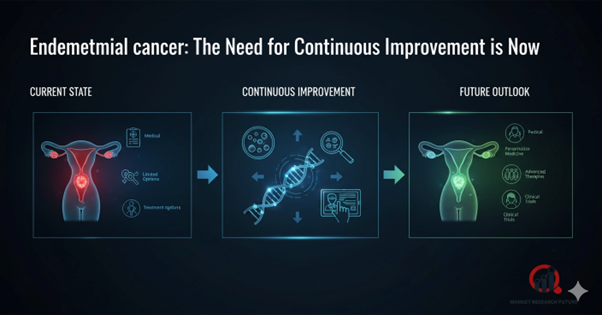Endometrial cancer: The Need for Continuous Improvement is Now

The Introduction to the Endometrial Cancer Market
With the rising geriatric population and rapidly changing lifestyles of consumers across the globe, the prevalence of endometrial cancer is increasing. The global endometrial cancer market development is set to adhere to a CAGR of 6.21% through 2035, promising the valuation of the sector to reach USD 32.77 billion from USD 16.89 billion in 2024.
Endometrial cancer is a malignancy that originates in the inner lining of the uterus, known as the endometrium. This layer thickens each month in preparation for pregnancy.
However, the cells of the endometrium sometimes fail to regulate their growth properly, leading to uncontrolled division. When these abnormal cells invade other tissues beyond the uterus, the condition progresses to cancer.
Symptoms and Diagnosis
The first sign of endometrial cancer is often vaginal bleeding or discharge, especially during or after menopause. The bleeding may not be heavy, and the blood may appear normal.
Doctors perform an endometrial sampling, inserting a thin tube through the vagina and cervix to collect cells for pathological examination. Diagnosis may also involve clinical history, physical examination, and imaging such as pelvic CT or MRI.
Treatment Options
Treatment depends on tumor stage, age, menopausal status, and prior radiotherapy history. Options include hysterectomy, endometrial ablation, chemotherapy, or radiotherapy.
Types of Endometrial Cancer
- Non-serous (Endometrioid) Cancers: Comprising 80–85% of cases, these cancers start in endometrial cells and generally grow slowly. They tend to remain localized and have a favorable prognosis.
- Endocervical Cancer: Arising from cervical tissue, these cells can spread to the endocervical lining and grow within it.
Prognosis
Prognosis depends on the type of endometrial cancer, patient age, disease stage at diagnosis, and tumor markers such as CA-125. The World Health Organization stages endometrial cancer using the FIGO system, part of the broader FIGO-AJCC classification.
Stage I cancers are small and appear confined to the uterus. Symptoms may include fatigue and lower abdominal pain, but any new symptom should be evaluated promptly.
Regional Analysis
The global endometrial cancer market is heavily influenced by regional healthcare infrastructure and awareness. North America, particularly the United States, leads due to advanced diagnostic capabilities, widespread awareness campaigns, and access to specialized gynecologic oncology care.
Europe follows closely, with Germany, France, and the UK investing in early detection programs and research initiatives. The Asia-Pacific region is witnessing rapid growth, especially in China and India, driven by increasing urbanization, rising healthcare expenditure, and better screening facilities.
Latin America and the Middle East and Africa remain emerging markets, where limited access to diagnostic tools and low awareness contribute to delayed detection. Overall, regional growth is propelled by initiatives to enhance early detection, advanced treatment availability, and rising awareness of women’s health issues.

Leave a Comment